Bridging the boundaries of science and art for business students: Integrating botany and artistic perspectives to teach environmental literacy
Rodgers Krcmar JSE Dec 20 2017 General
LINK: December 2017 General Issue: Curriculum and Change Table of Contents
INTRODUCTION
Students not specifically focusing in science, sustainability or environmental studies represent a large audience who often lack environmental literacy and feel disconnected from the natural world around them (Becker, 1997). Environmental literacy comprises an awareness of and concern about the environment and its associated problems, as well as the knowledge, skills, and motivations to work toward solutions of current problems and the prevention of new ones (NAAEE 2004). Engaging non-majors in learning environmental science concepts, observing and recognizing nature around them, and shifting their attitudes and behavior toward the environment can be challenging and often requires a multi-perspective approach.
It is critical for future business leaders to be aware of environmental issues and recognize how the choices they make will impact nature and human communities. Teaching business students the importance of sustainability and how/why to value nature can sometimes be difficult, but it is also a chance to engage in interdisciplinary learning and to provide critical and integrative thinking opportunities. There is increasing recognition that to be effective problem-solvers, all students must learn to integrate information from different disciplines (Brewer, 1999). In the past we have had success in shifting mindsets when creating innovative interdisciplinary exercises for our business students to learn sustainability concepts (Lester and Rodgers, 2012; Rodgers, 2013; Rodgers, 2015).
The field of botany (study of plants) provides the opportunity to teach important scientific concepts, address environmental and social issues, while also attempting to increase the visibility and awareness of the natural world. It has been found that students often have limited exposure to learning botany in high school (Hershey, 1996) and many do not notice the plants around them, resulting in the spread of “plant blindness” (Wandersee & Schussler, 1999). This pervasive plant blindness stems from a societal preference to detect, appreciate and empathize with fauna over flora (Bozniak 1994; Wandersee and Schussler 2001) and is due at least in part to a greater focus on animals in formal biology education (Balding and Williams 2016). Unfortunately, plant blindness leads to a lack of valuing plants as well as a chronic underfunding of plant conservation efforts (Kramer et al. 2010).
Since the visual arts are widely recognized as being effective in communicating issues, influencing people, and challenging accepted paradigms (Belfiore & Bennett, 2007), it can be a valuable tool for sustainability education (Thomsen, 2015). In addition, there have been recent calls to break down boundaries and connect science and art, especially in higher education and outreach (McKibben, 2005; Curtis et al., 2012; Inwood & Taylor, 2012). STEAM is a growing movement to integrate the arts into science, technology, engineering and math education, and it is fueled by both the National Science Foundation and the US Department of Education (Robelen, 2011). During a time when environmental educators are seeking new and more effective ways to convey complex environmental issues, the field of art education offers innovative and alternative ways to reach students (Inwood & Taylor, 2012).
Scientists consistently use and create visualizations as a means of representing new relationships, testing hypotheses, and explaining knowledge (LaTour, 1999; Gilbert, 2005; Nersessian, 2008). Although interpretation of visualizations and other information is clearly critical to learning, becoming proficient in science also requires learners to develop many observational and representational skills. Because it is an active process that caters to individual learner differences, drawing enhances student engagement and provides the opportunity for students to develop visual literacy in the varied conventions of representation. Unlike other constructive strategies such as writing reports or providing oral self-explanations, visual representations have distinct attributes that match the visual spatial demands of much of science learning (Ainsworth et al., 2011). It has been found that simply changing a student’s sensitivity to environmental issues can be critical to shaping how individuals consider the environmental and social implications of their decisions (Cordano et al., 2003) and that artistic images can be one effective way to do this (Blasch & Turner, 2015). In 1969 Sol Lewitt stated that “Successful art changes our understanding of the conventions by altering our perceptions” (Stiles & Selz, 1996). Arts-based inquiry has been found to make the linear narratives, common in traditional research, more complex (Leitch, 2006). Engaging with art, as artist and/or as viewer, can affect environmental behavior by creating an emotional affinity with nature, developing a cognitive interest in nature, and/or provoking emotional indignation about environmental harm (Curtis, 2009). Bringing art’s powerful ability to engage audiences with multiple dimensions of an issue to sustainability education diversifies the type of learning that might take place, increasing the likelihood that the learning will ‘stick’ with a wider range of students (Dunaway, 2009).
We report here on a unique in-class workshop and written reflection exercise we developed to: (1) interest our students in learning botanical concepts, (2) engage our students in careful observation and visualization of nature, and (3) increase the environmental sensitivity of students by connecting science and nature based art. We asked students to view, create (through drawing and painting) and conceptualize (in writing) works of botanical art as a multi-perspectival process of engaging with relevant scientific processes and sustainability concerns connected to botany.
BABSON COLLEGE AND THE ECONOMIC BOTANY COURSE
Babson College is a private 4-year college in Wellesley, Massachusetts, with a student body size of roughly 2,100. The class of 2020 is 47% female, 29% international, and 43% U.S. students of color (Babson College, 2017). Upon graduation all students receive a B.S. in business administration, with at least half of their credits earned in liberal arts and science courses. Currently these disciplines are taught separately to students and the expectation is that they will be able to take information learned from one class and apply it within a different class. Unfortunately, such interdisciplinary connections and integrative thinking are passively assumed by educators, but rarely realized by students (Rhoten, 2004; Klein, 2005).
While at Babson students can choose to earn a concentration within their business major by taking four courses focusing on one particular area. Options for the concentrations range from Entrepreneurship or Finance to Gender Studies or Literary and Visual Arts. In 2011 the Environmental Sustainability (ES) concentration was created. This concentration requires that students take one core environmental science-based course, developing their understanding of nature and current environmental problems, and then three elective courses from a list, including courses in science, humanities, business and economics. Economic Botany is one course that fulfills the elective requirement.
The Economic Botany (SCN 3630) course was designed as a new science elective course for Babson College in 2009 and since this time it has been taught roughly once a year to a full class of 25 students. Economic botany is a relatively recent field of study that analyzes the past, present and future uses of plants by people (SEB 2017), and therefore is inherently interdisciplinary. Our Economic Botany course is designed to investigate the relationships between plant biology and anthropology, and it provides a combination of natural science with business application that is appealing for our business students. The primary objectives of the course are to (1) explain how plants grow and reproduce, (2) identify and explain the purpose of the major parts of a plant, (3) discuss the primary roles for plants in society, (4) analyze the future role of plants in business, and (5) identify sustainable and unsustainable practices using plants. The course is taught with a clear focus on sustainability and plant conservation, emphasizing both environmental literacy and systems-based ecological literacy (Goodwin, 2016) Topics such as deforestation, biopiracy of medicinal plants, sustainable plant-based materials, biomimicry, and phytoremediation discussed throughout the semester. The course begins by exploring how plants grow and reproduce, the different structures within plants, and the incredible plant diversity around the world. The majority of the course focuses on examining plants as potential sustainable sources of food, materials/textiles, perfumes, medicines, pollution remediators, carbon sequesters, and vital producers of ecosystem services. Throughout the course we discuss the roles plants have played in different cultures by influencing language, arts, religion, and economics.
THE BOTANICAL ART WORKSHOP
We first combined an art workshop and lecture into the Economic Botany class in 2011 and repeated this activity in 2012. Then in 2014 we re-designed it to include an informational pre-class assignment, an in-class botanical art workshop, and a post-class written reflection, which we repeated in 2016. The pre-class assignment allowed us to utilize a ‘flipped classroom style’ (Mazur, 2009) so students were responsible for reading through a slide lecture and researching the lecture material on the botanical artists on their own before class, thereby opening up the class time for hands-on, active learning exercises. Having the students review the presentation on their own allowed them to select one or two artists and research the work that interested them most in more depth.
In order to provide a sample of the breadth of media and subject matter explored within the category of botanical art, the prepared slide lecture introduced the work of 26 artists (Table 1). The artists selected also took a broad range of approaches to their use and representation of plants, plant life cycles, and scientific processes. Some of the artists used plant imagery and plant materials to ask questions about what is natural or unnatural, engage issues of spirituality and mortality, while others used the plants to work in collaboration with community members to address environmental issues such as erosion, invasive species, and the production of sustainable fibers and clothing. The slide lecture represented artwork in a wide range of media from drawing, painting, photography, mixed media collage, video, installation, sculpture, ceramics, fiber, quilts, and community based artwork, i.e. social practice (Table 1). We selected a few well-known historic artists such as Giuseppe Arcimboldo and Georgia O’Keefe, but focused mainly on contemporary artists with international reputations. We also included New England based artists such as Lina Maria Giraldo, Deb Todd Wheeler, Thomas Matsuda, and Alison Williams, all four of whom have exhibited work at Babson College (Table 1).
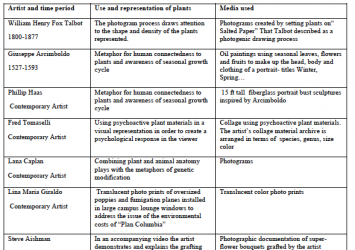
Table 1: Description of artists and their work that the students were introduced to within the pre-class slide show.
The workshop during class was an in-depth and hands-on activity where students were encouraged to bring in botanical structures (or they could choose from some that were collected for them) and learn to observe them carefully through drawing them. In doing this careful observation, students sketched the objects on paper using plant derived art materials such as vine charcoal, walnut ink, and botanically extracted paints from basil, pomegranate, plums, etc. (Figure 1). The processes involved in the production of paper, the walnut ink and charcoal were described during the workshop as a means of overtly connecting the plant sources to the art materials used. This was also referenced at various later points in the course.
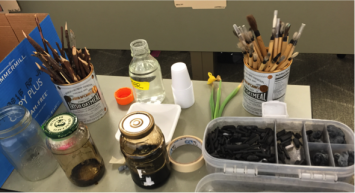
Figure 1: Walnut ink, bamboo brushes, sharpened twigs and charcoal used in the botanical art workshop in class (Photo Credit: VL Rodgers).
As most of the students were novices in artistic expression, we started by doing three introductory drawing exercises. They began with a blind contour drawing (Figure 2): where the student looks only at the botanical subject and not at his/her drawing on the paper in order to slow down and shift the focus to the processes of looking and seeing, rather than the completed drawing product as a means of deepening the level of observation. We found that students initially had difficulty with this, it is counter-intuitive and challenging to not look at one’s paper while making a drawing, but after a few tries, many started to notice different shapes, lines and details of their objects. The second exercise was a gesture drawing: where the student focuses on the quick representation of the general overall form rather than the details. This drawing was timed and forced students to quickly gather an overall observation or general view from their object. Lastly the students used a gesture drawing as the basis for a more developed drawing, allowing them to start with general forms and proportions that could be refined to greater clarity before fleshing out the details (Figure 3). This multi-stepped drawing exercise was designed to promote close observation, documentation, communication, and self-reflection in the students’ understanding of the botanical subject.

Figure 2: Our students participating in the blind contour drawing exercise within the botanical art workshop in class, looking closely at their botanical subjects but not at the paper they were drawing on. (Photo Credit: VL Rodgers).
As a way of reinforcing the careful observation and science-art integration from the botanical art workshop, throughout the remainder of the course students were periodically given flowers, fruits, leaves or seeds to dissect, draw, and label with botanical terms. In addition, during one fieldtrip to local greenhouses, students were asked to select two plants to sketch with a close-up careful observation of one part as well as a quick overall sketch and include as many botanical terms, details and careful observations as possible. Although specific metrics were not collected for each class, we noticed that during the years that we ran the botanical art exercise (roughly 25 students participated in 2011, 2012, 2014, and 2016), students tended to include greater detail and demonstrate more careful observation, often including multiple views and better botanical labeling, as compared to prior years.
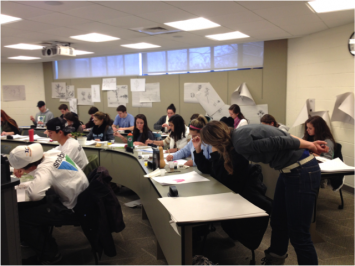
Figure 3: Our students participating in the more detailed drawing exercises within the botanical art workshop in class (Photo Credit: VL Rodgers).
STUDENTS RESPONSES AND REFLECTIONS
As a way to gauge how the students perceived their own learning and enjoyment with the art activities on the last day of the 2014 course we gave the students a three question paper survey to fill out and return anonymously. The first two questions were statements that asked students to respond whether they ‘strongly agreed’, ‘agreed’, ‘felt neutral’, ‘disagreed’, or ‘strongly disagreed’ with the following statements: (1) Overall the art and the artistic perspectives helped me in understanding the botanical concepts/scientific processes, and (2) As a student not majoring in either science or art, I enjoyed blending science with art to learn botany. The third question was open-ended and asked students to briefly write down any observations they had after participating in the botanical art workshop. In compliance with the college’s Institutional Review Board, students were informed of the study protocol and those willing to participate anonymously completed the questionnaire.
Drawing to learn science has been a critical technique in larger attempts to have students learn inductively (Lerner, 2007). Data have shown that active learning, which drawing can be considered to be a part, increases student performance in science (Freeman et al. 2014). Through drawing, students visually demonstrate their depth of understanding of scientific forms and concepts. Although this is a small group, 14 out of 19 students responded that overall they perceived that the art and artistic perspectives helped them in understanding the botanical concepts/scientific processes (agreed or strongly agreed; Figure 4). In addition, 16 out of 19 students agreed or strongly agreed that as a student not majoring in either science or art, they enjoyed blending science with art (Figure 4).
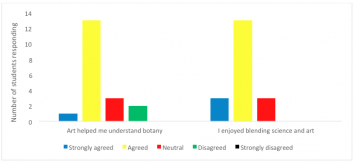
Figure 4: In a written survey, the number of students responding whether they ‘strongly agreed’, ‘agreed’, ‘felt neutral’ or ‘disagreed’ with the following statements: (1) Overall the art and the artistic perspectives helped me in understanding the botanical concepts/scientific processes, and (2) As a student not majoring in either science or art, I enjoyed blending science with art to learn the botany.
In the open-ended question a majority of student responses demonstrated an appreciation of the details and complexities of plants. Below are some representative statements from individual students when asked to write down any observations they had after participating in the botanical art workshop:
“It was very helpful to see the unique intricacies up close and personal”
“It allowed me to observe the finer details of the plant and appreciate how complex they are.”
“It helped me see the scientific parts of the plant more clearly”
“By looking at different angles and focusing on different plant parts I was able to see plants details more easily rather than focusing on the overall appearance of it.”
“It really helped me consider the details of the whole plant, not just what you have pictured when you hear the word onion for instance”
“I have been seeing different things outside and thinking how they could be used as art materials”
“I’ve thought about constructing something artistic/furniture from pieces of wood”
“See more art and beauty in plants now and pay more attention to detail (leaf shape, grooves in bark, etc.)”
“When we went to the Wellesley greenhouses it showed me the variety of plants and how different they can truly be”
We also assigned a post-class written reflection as a way for students to demonstrate any increased understanding or environmental sensitivity that may have come from connecting botany and nature based art. This written reflection asked students to give some thought to a botanical art project they might like to make if they had full access to any materials. Students were asked to describe (1) what they would make, (2) how they would make it, and (3) why they would make it, or what would it represent? These reflections were limited to 2 typed pages. After grading the reflections as an assignment for the course, students were then individually asked for consent in anonymously including their responses in our study.
Three of the artists whose work students responded strongly to were: Steve Aishman, Thomas Matsuda, and Alison Williams. For his photographic series “Superflowers”, Steve Aishman successfully grafted completely different species of flowers onto one root stock. The resultant flower photographs appear to have been photo shopped but are actually the unaltered representations of the living grafted plants. Thomas Matsuda, is a contemporary sculptor who apprenticed 12 years with renowned traditional Buddhist Sculptor Kouko Eri. Matsuda’s wood and stone carvings and rubbing drawings speak to the temporal quality of life while also revealing specific scientific details of tree anatomy. Alison Williams creates installation, sculpture constructions, and mixed media pieces that take inspiration from the garden and utilize its natural cycles of germination, growth, and eventual decay. Williams buries some of her canvases and photographs in the garden for several months, integrating decomposition into the creative process and turning the New Hampshire weather into a collaborator.
In the written reflections, 9 out of 17 students referred to at least one artist from the pre-class presentation as a starting point or influence in the imagining of their own piece of botanical art (Table 2). There were 5 strong examples of students combining art and science. Two students proposed projects that would simultaneously showcase plant diversity and different stages of the plant life cycle, both utilizing a garden as the framework. One, influenced by the carvings of Thomas Matsuda, proposed that he might make a wood carving of a sunflower, thus representing a common plant (a sunflower), using materials from a tree. He specifically highlighted the recreation of a living organism (spiritually) through a dead organism (old wood from a tree). His piece represents the plant cycle when dead plants are consumed by the soil to create more nutrients for a new plant to grow. Another student, influenced by Alison Williams, proposed slide dissections of a set group of plants as a means of displaying the active anatomy of the plants above and below ground. Another student proposed creating a partial field guide series of paintings of coastal plants that grow from New England to Maryland as a sort of homage to his grandmother who had painted seascapes off the coast of Long Island (Table 2).
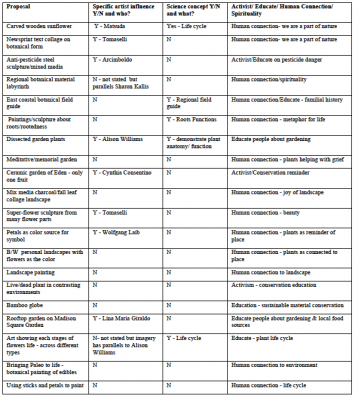
Table 2: Summaries of student responses as written reflections when asked to create a piece of botanical artwork. Reflections were noted whether specific artists served as influence, scientific concepts were explained, and human connection to nature discussed.
Most students proposed artworks that spoke to their sense of connection to the nature or a desire for environmental stewardship. Three students proposed works that would educate viewers about the harm of pesticides and the benefits of locally grown food. Four students proposed works that referenced autobiographical connections to the landscape and environment, and three others proposed works that addressed a spiritual connection to the environment. One student, who went on to start her own business in organic soil amendments, described making a piece that would combine newsprint with man-made fonts and text onto organic forms as a way to communicate “… that we too are part of nature, and even if we artificially remove ourselves temporarily, it will encompass us again.” For many of these students the full cycle of the art exercise provided them a means to deepen and articulate a connection to the environment, as well as a cognitive interest in nature (Table 2).
DISCUSSION OF WHAT WE LEARNED AND FUTURE PLANS
A number of our students were able to discuss a relatively high level of environmental sensitivity in their written reflections through connecting economic botany, environmental science and nature based art. By requiring students to carefully observe and then draw different plant parts both during the art workshop described here but also later throughout the semester, some students reported high visual engagement with the material, which is known to promote science learning (Ainsworth et al., 2011). It was particularly interesting to note that on the final exam when asked to describe the process of grafting at least three students specifically mentioned Steve Aishman’s artwork, thereby indicating that this artistic visualization stuck with them as an explanatory tool for the botanical process.
There is growing literature suggesting the benefits of integrating art in communicating science (Root-Bernstein et al., 2011; Schwartz, 2015), and there is an increased appreciation for the benefits of art-science collaborations in both elementary schools (Çil, 2015) and undergraduate education (Gurnon et al., 2013). We consider the workshop and activities described here to be a potential guide for others who may be trying to find small ways to start the process of blending these disciplines. Often institutional logistics make inter- or multi-disciplinary courses difficult to propose and manage, but activities similar to what we have described here provide a venue to begin some of these approaches, even if on a small-scale.
Going forward we are considering ways to help students make stronger and more overt connections between science, sustainability and art as well as ways to help students be more conscious of changes in how art allows them to perceive environmental concepts and vice versa. In particular, we have discussed bringing back botanical art images throughout the semester when appropriate botanical processes are being discussed. We may also include a short quiz during the at home lecture slide activity, simply asking students to consider specific scientific and sustainability concepts for each of the artists they explore. The challenge in making more overt connections for students lies in doing this without overloading the artist slide lecture, which some students already found to have more than an adequate number of artists included.
A number of students detailed significant personal connections to nature in their written reflections. One potential way to enhance the students’ connection to nature and their role within it would be to bring the botanical art project full circle and assign the students to create their own piece of botanical art. This could be done in lieu of or in conjunction with the imagined botanical art piece. In 2012 we had the students actually create their own botanical art piece, which, was limited by time, materials, and ability constraints in ways that the imagined works were not. Students worked with botanical elements such as leaves, wood and grasses to make artworks as well as using more familiar art materials and processes such as colored pencils, painting, or photography. There were five students who used botanical materials to create their artworks: two were collages with leaves and flowers, one was an ikebana study, and one student, who ran his own professional make-up artist business, worked with a model to create “botanical make-up” through applying colorful leaves to the model’s face and documenting the piece through photography. Make up is perceived by many as being unnatural, yet by using art to bring his own experience into a botanical framework, the student used the human desire for beauty through bodily ornamentation to build a connection to nature. The creation of an environmental work of art provides students with a sense of agency and the ability to share their understandings of environmental and societal issues (Inwood & Taylor, 2012).
CONCLUSIONS
We report here on one way we were able to engage and interest our students in enhancing their environmental literacy by integrating artistic perspectives with botany to learn scientific concepts, observe and recognize nature, and potentially shift their attitudes toward the environment. Although our students were all business majors and therefore specialized in their chosen field of study, they can also more generally represent a group of non-science and non-art majors. Overall the students perceived that learning the artistic perspectives helped them in understanding botanical concepts, sustainability issues and scientific processes and the majority enjoyed blending science with art. In addition, our approach allowed many of our students to perceive, recognize and visualize the details of plants more carefully and to reflect thoughtfully on their views toward the environment and their own connections to nature. With current environmental concerns it is becoming increasingly imperative for all students, especially those not majoring in science, sustainability or environmental studies, to understand scientific concepts, to enhance their observational skills, and to see themselves as connected to the natural world. Integrating art with botany is one way to work toward this.
ACKNOWLEDGEMENTS
We would like to thank the Babson Faculty Research Fund and Babson’s Sustainability Office for their generous support of this project. We would also like to thank our students as well as Babson College for encouraging faculty to engage in innovative teaching across disciplines. In addition, we thank the artist Jane D. Marsching for her careful review and helpful edits of a previous version of the manuscript.
REFERENCES
Ainsworth, S., Prain, V., & Tytler, R. (2011) Drawing to learn in science. Science, 333, 1096-1097.
Babson College. (2017) Undergraduate class profile for the class of 2020. Available from http://www.babson.edu/admission/undergraduate/class-profile/Pages/default.aspx
Balding, M., & Williams, K.J.H. (2016) Plant blindness and the implications for plant conservation. Conservation Biology 30(6), 1192-1199.
Blasch, J., & Turner, R.W. (2015) Environmental art, prior knowledge about climate change, and carbon offsets. Journal of Environmental Studies and Sciences, 1-15.
Becker, T. (1997) The greening of a business school. Journal of Environmental Education, 28(3), 5-9.
Belfiore, E., & Bennett, O. (2007) Rethinking the social impacts of the arts. International Journal of Cultural Politics, 13(2), 135–151.
Bozniak, E.C. (1994) Challenges facing plant biology teaching programs. Plant Science Bulletin 40, 42-46.
Brewer, G.D. (1999) The challenges of interdisciplinarity. Policy Sciences, 32, 327–337.
Çil, E. (2015) Integrating botany with chemistry and art to improve elementary school children’s awareness of plants. American Biology Teacher, 77(5), 348-355.
Curtis, D.J. (2009) Creating inspiration: the role of the arts in creating empathy for ecological restoration. Ecological Restoration Management, 10, 174–184.
Curtis, D.J., Reid, N., & Ballard, G. (2012) Communicating ecology through art: what scientists think. Ecology and Society, 17(2) 3.
Cordano, M., Ellis, K.M., & Scherer, R.F. (2003) Natural capitalists: Increasing business students’ environmental sensitivity. Journal of Management Education, 27(2), 144-157.
Dunaway, F. (2009) Seeing global warming: contemporary art and the fate of the planet. Environmental History, 14(1), 9-31.
Freeman, S., Eddy, S., McDonough, M., Smith, M.K., Okoroafor, N., Jordt,H., & Wenderoth, M.P. (2014) Active learning increases student performance in science, engineering, and mathematics. Proceedings of the National Academy of Sciences of the United States of America, 111(23), 8410-8415.
Gilbert, J.K. (2005) Visualization in science education. New York, NY: Springer-Verlag.
Goodwin, T. (2016) Educating for ecological literacy. American Biology Teacher, 78(4), 287-290.
Gurnon, D., Voss-Andreae, J., & Stanley, J. (2013) Integrating art and science in undergraduate education. PLoS Biology, 11(2), 1-4.
Hershey, D.R. (1996) A historical perspective on problems in botany teaching. American Biology Teacher, 58(6), 340-347.
Inwood, H.J., & Taylor, R.W. (2012) Creative approaches to environmental learning: Two perspectives on teaching environmental art education. International Electronic Journal of Environmental Education, 2(1), 66-75.
Klein, J.T. (2005) Integrative learning and interdisciplinary studies. Peer Review, 7(4), 8-10.
Kramer, A.T., Zorn-Arnold, B., & Havens, K. (2010) Assessing botanical capacity to address grand challenges in the United States. Available from http://www.bgci.org/usa/bcap
Latour, B. (1999) Pandora’s hope: Essays on the reality of science studies. Cambridge, MA: Harvard University Press.
Leitch, R. (2006) Limitations of language: Developing arts-based creative narrative in stories of teachers’ identities. Teachers and Teaching: theory and practice 12(5), 549-569.
Lerner, N. (2007) Drawing to learn science: Legacies of Agassiz. Journal of Technical Writing and Communication, 37(4), 379-394.
Lester, T. & V.L. Rodgers. (2012) Teaching a cross disciplinary environmental science, policy and culture course on Costa Rica’s ecotourism to business students. Journal of Environmental Studies and Sciences, 2(3), 234-238.
Mazur, E. (2009) Farewell, lecture? Science, 323(5910), 50-51.
McKibben, B. (2005) What the world needs now, is art, sweet art. Grist Available from http://grist.org/article/mckibben-imagine/
North American Association for Environmental Education (NAAEE). (2004) Excellence in environmental education: guidelines for learning (K–12). NAAEE, Washington, D.C., USA.
Nersessian, N. (2008) Model-based reasoning in scientific practice. (R. Duschl & R. Grandy, Eds). Teaching scientific inquiry: Recommendations for research and implementation. Rotterdam, Netherlands: Sense Publishers, 57–79.
Rhoten, D. (2004) Interdisciplinary research: Trend or transition. Items and Issues, 5(1-2), 6-11.
Robelen, E.W. (2011). STEAM: Experts make case to adding the arts to STEM. Education Week 31(13) 8.
Rodgers, V.L. (2015) A SEERS approach to analyzing impact: Using a science research project to evaluate product life cycle sustainability. (V. Crittenden, N. Karst, R. Sleggers, & K Esper, Eds). Evolving entrepreneurial education: Innovation in the Babson classroom. UK: Emerald Publishing, 399-409.
Rodgers, V.L. (2014) Pitching environmental science to business majors: Engaging students in renewable energy choices. Journal of College Science Teaching, 43(5), 28-32.
Root-Bernstein, R.S., Siler, T., Brown, A., & Snelson, K. (2011) ArtScience: Integrative collaboration to create a sustainable future. Leonardo, 44, 192.
Schwartz, B. (2014) Communicating science through the performing arts. Interdisciplinary Science Reviews, 39, 275–289.
Society for Economic Botany (SEB). (2017) Economic Botany. Available from http://www.econbot.org
Stiles, K., & Selz, P.H. (1996) Theories and documents of contemporary art: A sourcebook of artists’ writings. Berkeley, CA: University of California Press.
Thomsen, D.C. (2015) Seeing is questioning: prompting sustainability discourses through an evocative visual agenda. Ecology and Society, 20(4).
Wandersee, J.H., & Schussler, E.E. (1999) Preventing plant blindness. American Biology Teacher, 61(2), 82-86.
Wandersee, J.H. & Schussler, E.E. (2001) Toward a theory of plant blindness. Plant Science Bulletin 47, 2-7.







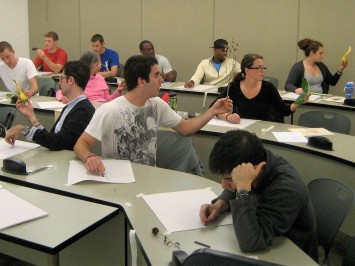



 Vikki Rodgers is an Associate Professor of Environmental Science and Ecology at Babson College where she teaches business students and performs field ecology research. She earned her Ph.D. in Forest Ecology in 2007 from Boston University. She can be reached via email at vrodgers@babson.edu
Vikki Rodgers is an Associate Professor of Environmental Science and Ecology at Babson College where she teaches business students and performs field ecology research. She earned her Ph.D. in Forest Ecology in 2007 from Boston University. She can be reached via email at vrodgers@babson.edu  Danielle Krcmar is the Associate Director of Visual Arts at Babson College where she teaches studio art classes, directs the Hollister Gallery, and creates sculpture and installation work. She earned her MFA in Sculpture in 1996 from UMASS Amherst. She can be reached via email at dkrcmar@babson.edu
Danielle Krcmar is the Associate Director of Visual Arts at Babson College where she teaches studio art classes, directs the Hollister Gallery, and creates sculpture and installation work. She earned her MFA in Sculpture in 1996 from UMASS Amherst. She can be reached via email at dkrcmar@babson.edu 
